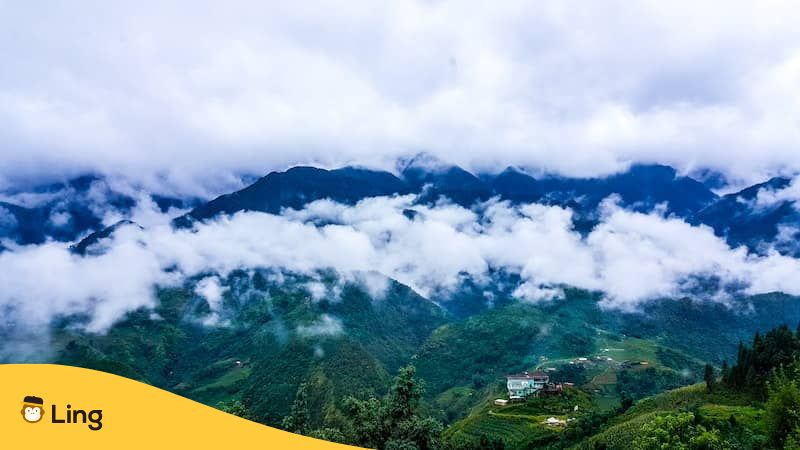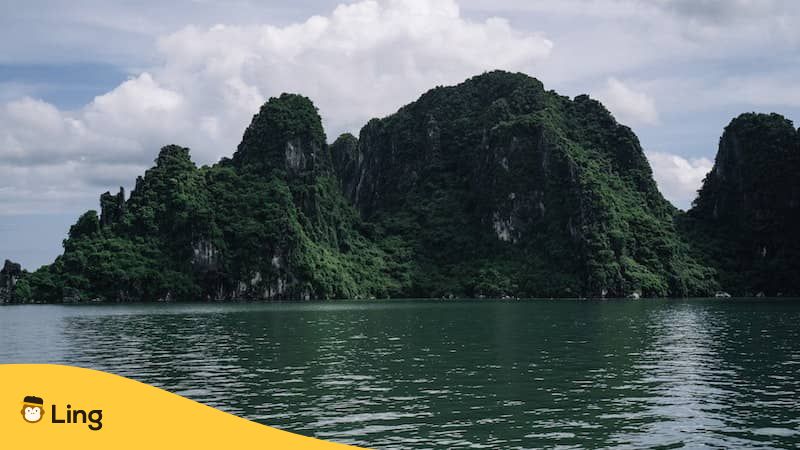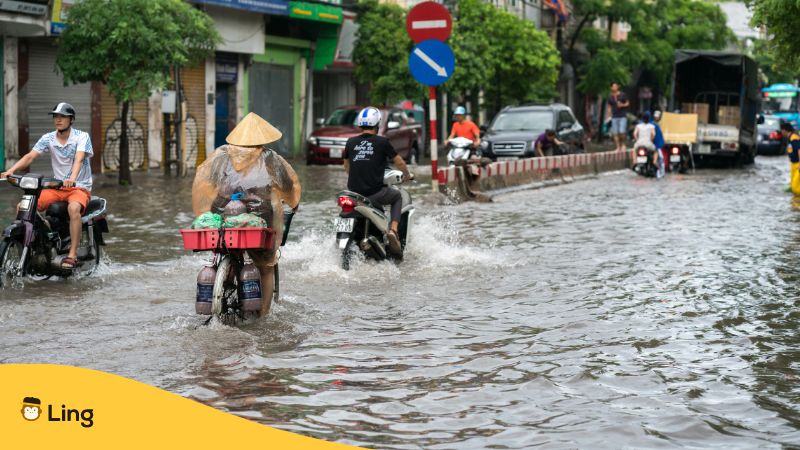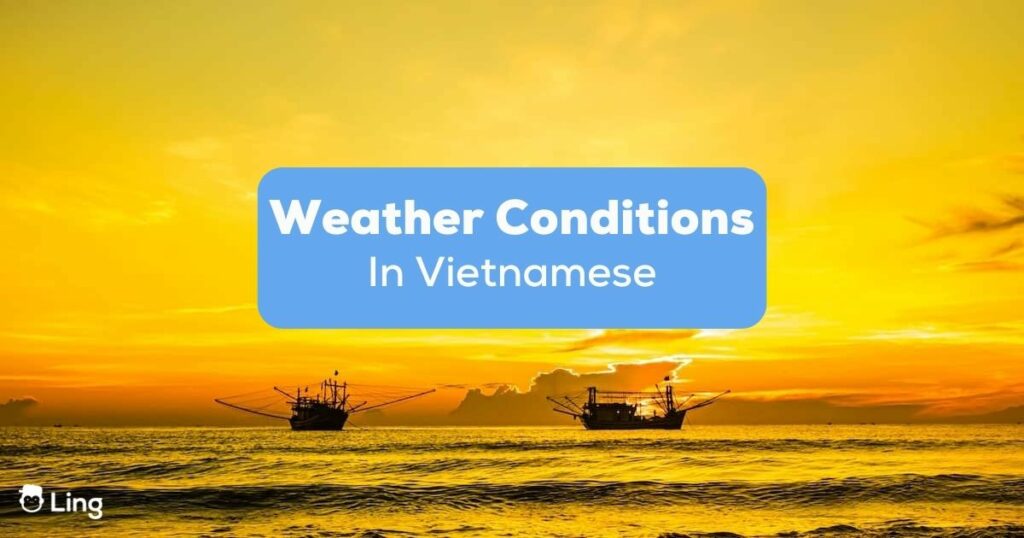The first time I came to Vietnam, I was shocked by the weather. I’m from England, and you can pretty much guarantee on any given day, it will be lightly drizzling. However, in Vietnam, one minute you find yourself in unbearable 35-degree heat, and the next, there’s a torrential thunderstorm, and the mercury has dropped to 25. Today we’re investigating weather conditions in Vietnamese and bringing you the most helpful vocab we can think of.
Have you hit a stormy patch in your second language learning? Ling is here to usher in sunny days with its innovative language learning course. Practice reading, writing, speaking, listening, and vocab with Ling.
Weather Conditions In Vietnamese – The Basics
Here are the basic words you’ll need to describe the weather in Vietnam. As with any country, talking about the weather is a great conversation starter.
| English | Vietnamese | Sound |
| Cloudy | Nhiều mây | |
| Foggy | Sương mù | |
| Rainy | Nhiều mưa | |
| Snowy | Có tuyết rơi | |
| Stormy | Bão | |
| Sunny | Nhiều nắng | |
| Windy | Có gió |
Weather Conditions In Vietnamese – Complete List A-H
These are more specific terms to describe and talk about the weather in Vietnamese. Also included are the seasons, although Vietnam doesn’t experience the four seasons like some parts of the world.
Weather Conditions In Vietnamese – Complete List I-Z
Let’s continue on! There are quite a few weather terms to learn and yes, ice is possible, especially in the mountains of Sapa in Norther Vietnam.

Weather Conditions In Vietnamese – Useful Phrases
Are you ready to move on to the next stage?
If there’s one thing I’ve discovered while traveling to 25 different countries, it’s that there are certain human universals. Can you guess what the number 1 is?
Weather. It doesn’t matter if you’re in Ho Chi Minh City or Halifax, the local man at the corner shop will glance fretfully at the sky and say something like ‘looks like rain’ (Trời có thể mưa).
It isn’t enough to say one word in response. You need to offer your own opinion of the situation, and here are some phrases in Vietnamese that could help you.
What Is The Climate Like In Vietnam?
Generally speaking, Vietnam is divided into two different climate zones. Although both are tropical, there are differences.
Vietnamese people like to think of the Central highlands in Central Vietnam as like a wall that divides them.
The good news is that if you’re in the North, you will experience four distinct seasons. Many ex-pats wax lyrical about how beautiful Hanoi is in the Autumn, which usually starts in September- October. (The seasons in Hanoi actually correspond to seasons in Northern Europe, although Hanoi can still be very hot in even November(As I write this from Hanoi on November 4th, the daytime temperature is 30 degrees). In December and January, it can drop to about 10 but rarely lower than this except in the highlands, where you can even see snow.
July and August are generally bad times to visit Northern Vietnam because monsoon rains wash in from the East Sea, and the temperature is boiling(hotter than the south).
The South of Vietnam’s weather is categorized as a wet and dry season (the temperature never much changes but the difference in the amount of rainfall is staggering). Annual precipitation in Ho Chi Minh City is 55 inches. This is something to keep in mind if you like hiking.
The rainy season in the south is from May to November. An exception is the highland region of Dalat, where the weather stays temperate year-round. The best time to visit the south is January, or February, although it’s best avoided if you like a quiet getaway, as everywhere is super busy!
Northern Vietnam
Far north, Hanoi experiences chilly winters with temperatures dipping down to around 10°C (50°F) or even lower. Summers can get over 30°C (86°F).
Central Vietnam
This region, including cities like Da Nang and Hue, boasts a more stable tropical climate. The temperatures range from 24°C to 30°C (75°F to 86°F) throughout the year.
Southern Vietnam
Places like Ho Chi Minh City bask in the tropical sun year-round with the average temperature ranging from 25°C to 35°C (77°F to 95°F).

Climate Change And Vietnam
Vietnam, like every other country in the world, is subject to the effects of climate change and the rise of average temperatures; however, because of Vietnams erratic weather systems, propensity for natural disasters, and status as low-income, its people feel the effects perhaps more than most.
A particularly worrying trend is found in Southern Vietnam in the Mekong Delta, where a 2 part process is putting lives at risk.
The Mekong Delta is sinking into the sea, and at the same time, sea levels are rising, claiming more and more homes every year. Although homes are what usually make the news, another facet that people don’t think about is the amount of farmland that is also gobbled up by the unrelenting waters. These numbers are terrifying when you consider that 18 million people live in the Mekong Delta, and most of them barely live above current sea levels.

Rainfall And Monsoons In Vietnam
Vietnam has two main monsoon seasons:
Northeast Monsoon
This monsoon typically arrives between mid-November and April. It’s a game-changer, bringing cooler and drier air from the northeast. Northern Vietnam, including Hanoi, experiences its cooler winter months during this period. In contrast, central and southern areas get a break from the relentless heat and humidity, allowing people to bring out a light raincoat in case of rainfall or jacket.
Southwest Monsoon
The southwest monsoon (hello, rainy days) hits Vietnam from May to early October. During this time, warm and moist air masses from the southwest sweep across the country. This brings the highest rainfall and tropical storms, especially to the central and southeast regions. Expect heavy afternoon downpours, heavy rainfall, tropical cyclones, storms, and even flooding.
Emergency Words Related To Weather Conditions
Believe it or not, weather is a fantastic conversation starter when learning a new language like Vietnamese. Weather is a topic that comes up in everyday conversations. Knowing weather-related vocabulary and phrases equips you to engage in meaningful discussions with locals. But when disaster hits, make sure that you know the following words and phrases that can help you navigate your way and ease through any emergency situations:
- Emergency – Khẩn cấp
- Help – Giúp đỡ
- I need assistance – Tôi cần sự giúp đỡ
- Police – Cảnh sát
- Hospital – Bệnh viện
- Fire – Hỏa hoạn
- Evacuate – Sơ tán
- Safety – An toàn
- I am lost – Tôi bị lạc đường
- I am injured – Tôi bị thương
- Where is the nearest shelter? – Nơi trú ẩn gần nhất ở đâu?
- Is there a safe place nearby? – Có nơi an toàn gần đây không?

Learn Vietnamese With Ling
The climate data out of Vietnam can, at times, seems discouraging. There are increasingly extended periods of dry weather followed by a deluge.
But you should still visit Vietnam and learn Vietnamese. We all have to face climate change together, and by taking a vacation to the country, you are helping give locals much-needed money that could prepare them for whatever changes may occur in the future.
We know you’ll have a great vacation, and learning Vietnamese is just the cherry on top of the cake that will allow you to connect with locals in a way you didn’t think was possible.
If you enjoyed this blog, check out a few others, such as vocab about diet in Vietnamese and Vietnamese tones.
Thanks for reading



































































